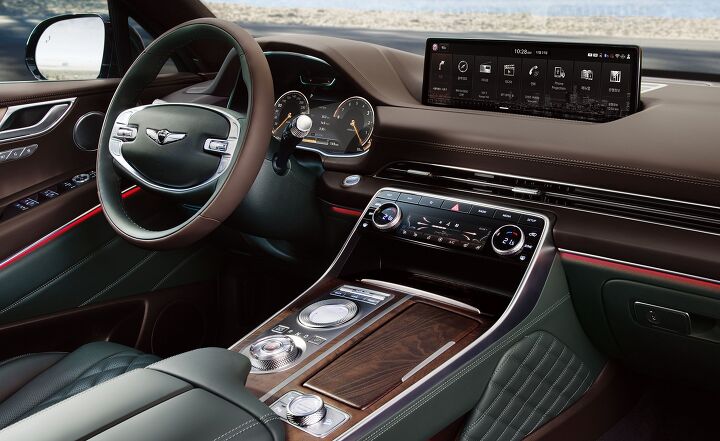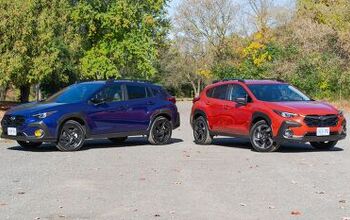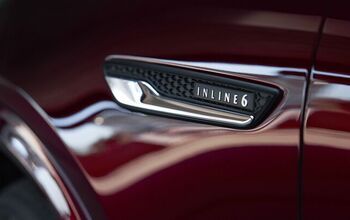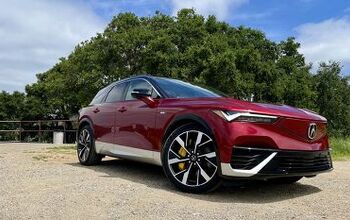The More Options the Better: How Genesis Rethought Its Infotainment System for the 2021 GV80 and G80

One of the unique perks of this job is learning the ins and outs of every manufacturer’s take on infotainment.
The tough thing for user interface designers is that there’s no such thing as a silver bullet, of one “right” approach—but there can definitely be wrong ones.
For Genesis, the time is now for a complete rethink of its own infotainment approach. The brand’s first SUV is about to land in North American dealerships, drawing in new buyers at a rate that, according to Genesis’ online reservations, has outstripped everything that’s come before from the Korean brand. It’s a big deal then, as well as its sister model, the second-generation G80 sedan. Talking with Andre Ravinowich, the manager of product planning and strategy with Genesis North America, it becomes clear that the team decided on its approach early on: offer as many input options as possible.
SEE ALSO: 2021 Genesis GV80 Preview: Hands On With the New Luxury SUV“The multiple inputs was definitely a choice made to allow, whether you’re the driver or the passenger, to choose how you want to best interact with the car,” explains Ravinowich.” Genesis didn’t want to corner buyers into using either a controller or a touchscreen, so the new 80-series models have both. Part of that also comes down to the physical size of the screen, a massive 14.5 inches. “It’s a pretty big screen, so when you’re driving you can’t touch the far end, especially on the GV80, it’s kind of a long reach,” says Ravinowich, “but on the flip side, that’s where we have the controller, which has quite a lot of capability built into it, and the cloud-based voice recognition that adds a lot more flexibility to how you interact with the car.”
Ravinowich isn’t just quoting the company lines either: he previously worked on vehicle technology. He acknowledges current models like the G70 use a shared multimedia platform from within the vast Hyundai Motor Group. That was a necessity at the time, but the GV80 draws a line in the sand, with the first ground-up platform built exclusively for the luxury automaker. He talks about the importance of adding a voice assistant as in other luxury marques, but that it needed to feel natural. The goal with voice interaction, according to Ravinowich, is to keep people focused on the driving and to get away from looking at screens. “A lot of challenges we had in the past were with precise commands. Those sorts of things are getting better now,” he tells me during our phone interview. “If you have to go through 14 steps to enter an address with the touchscreen, but you can do it by voice, it’s a lot simpler.”
I’ve had some time to interact with the revamped Genesis system in both models. The central controller features a lot of functionality. The tactile delight of its iPod-like scrolling is one of the first things I expect folks will notice, but it also functions as a four-way arrow. There’s also handwriting recognition on the center-most element, with the smartphone-like ability to swipe backwards to delete. Ravinowich tells me these multiple input choices were combined to ensure the right type of controller depending on the task at hand. A four-way arrow is simpler for more grid-like menus, but it could take forever to scroll through satellite radio stations. CarPlay is another example: the non-touchscreen systems in other manufacturers have to adapt to an interface designed for touch, and it always results in awkward inputs for the user.
The one input option the GV80 and G80 won’t ship with is gesture controls, a la BMW. No twirling your hand to lower the volume or open the sunroof, then. I take the opportunity to ask Ravinowich which systems the team benchmarked for the new Genesis infotainment, but also which he personally finds the best. You know, besides Genesis. He starts with the typical response, that the R&D team looked at everything in the premium space. But he soon singles out Mercedes and its MBUX platform:
“It’s done a pretty good job of making things quite interactive. For example, their home screen, how it’s dynamic, so you’re not just looking at a static list of things on a menu. As you’re scrolling through the home screen, you can see your radio station, your directions, they’ve done a really good job of making the experience quite fluid. Maybe to me, on a personal level that’s one of the better ones out there.”
At this point Jarred Pellat, PR on the Genesis Canada team, jumps in. “If you look at the J.D. Power Tech Experience Index (TXI) that came out, Hyundai was ranked as the number one mass-market brand,” says Pellat. “Genesis was above Hyundai, fifth overall and obviously fifth in premium, which is way above the industry average. So I think the proof is in the pudding there, it’s not just biased ol’ Jarred, but a lot of people out there are starting to realize that our human-machine interface is really, really good.”
On the flip side, while neither Pellat nor Ravinowich will name names, there’s a certain competitor’s approach that rubs both the wrong way. “Every time I get into their vehicle and I have to deal with their trackpad…” Pellat trails off as they both laugh. I may have worked with them in the past, I have no idea what you’re talking about Jarred,” chuckles Ravinowich, before returning to the earlier subject of real users’ experiences.
“When I joined the company four or five years ago, I had the same impression Jarred said. When you get into our cars, things are so simple you really quickly get comfortable. In other models there’s a learning curve, some feel like to me that they’re backwards, you go left and it feels like the menus are going right. Things that don’t make logical sense, and a lot of times it’s for the sake of making it seem more fresh and different. I’m not saying we’re not, but I think for us, it’s more about usability than anything else.”
That focus on usability extends beyond the infotainment system. I bring up active driving aids, things like the Blind Spot View Monitor and Safe Exit Assist, both of which will be available on the GV80.
For the Genesis team, these both are examples of efficiency, of maximizing what buyers are getting out of the car. They both use existing hardware: BSVM uses the surround-view cameras, while SEA uses the blind-spot radar. It’s how the information is displayed to the users that matters. Importantly, for both Genesis and the buyer, these sorts of features don’t add any cost to the car: it’s software programming.
SEE ALSO: 2021 Genesis G80 Preview: Hands On With the Korean 5 Series FighterWe return to the subject of J.D. Power. I ask how much emphasis Genesis puts on results there, especially since it’s done so well in numerous studies, and with J.D. Power recently rebalancing the Initial Quality Study (IQS) to put more emphasis on infotainment. Pellat takes the lead here:
“As you noted, IQS, four years in a row, (we’ve been the) number one premium automaker, And then in our first year of eligibility, we won the vehicle dependability study,” says Pellat. “So obviously the quality of the vehicles is exceptional. These are surveys too, it’s not a scientific study, it’s how consumers feel about the cars, that they’re exceptional quality.”
Both Pellat and Ravinowich admit that this new system will have “a little bit of a learning curve” for consumers. But they also add that it’s a prime opportunity for the post-sale side of the business to shine. “The worst thing that can happen is that you own a GV80, and you’ve got all this great tech that can make your driving experience that much better, and you don’t even use it,” says Pellat. “You don’t activate the Genesis Connected Services. You don’t know how to use the voice control. That’s a real shame.” That’s where the dealerships and experience managers step in, helping new buyers learn more about their car. The current global landscape has also pushed more dealer/customer interactions online, which gave Genesis a competitive advantage. In Canada, the brand has operated without dealerships, instead focusing on online purchasing and experience spaces. That approach is now being adopted south of the border, with over 100 dealers offering a similar service, where you can purchase a vehicle at home or online.
Ravinowich adds in: “I think that’s part of why we tried to do things the way we do. I mentioned before, maybe we’re not always the first to adopt a certain feature, but do it in a way that’s easy to understand. Kind of like Apple: the best thing about the iPhone is you can use them as an instruction manual. I think our product has some of those qualities, that you can interact with them quite easily without doing a long process to learn how to use them.”
Pellat wraps it up: “You can connect with your Genesis Experience manage remotely, and on multiple occasions. It’s not just “oh today’s the day your car’s being delivered, come pick it up, goodbye, never see you again.” That’s a very traditional way of doing auto sales in North America, and Genesis is moving away from that.”
The Genesis GV80 and G80 will both begin showing up in North American dealerships before the end of the year.
Become an AutoGuide insider. Get the latest from the automotive world first by subscribing to our newsletter here.

Kyle began his automotive obsession before he even started school, courtesy of a remote control Porsche and various LEGO sets. He later studied advertising and graphic design at Humber College, which led him to writing about cars (both real and digital). He is now a proud member of the Automobile Journalists Association of Canada (AJAC), where he was the Journalist of the Year runner-up for 2021.
More by Kyle Patrick







































Comments
Join the conversation